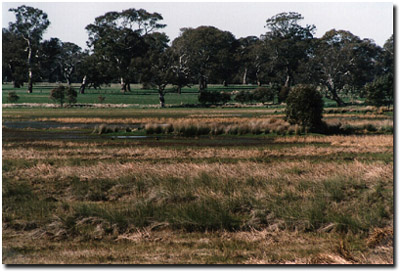Site 11: Bittern Lagoon, Racecourse Road (issue: wetlands)
Back to Bet Bet Creek Catchment Homepage
Landscape
This little gem is located at the rear of the Langi Kal Kal Prison. It was revegetated in 1986 using employment program participants and inmates from the then Training Centre. Today it provides a vision of what life around a thriving wetland community would have resembled. The Bittern lagoon is one of many swamps on this volcanic plain that extends south to Lake Burrumbeet. A number of the former swamps have been drained for agriculture but several good examples still exist today, notably the Piccaninny swamps and the Cockpit lagoon. For the local aboriginals it is easy to see why so much life revolved around wetlands, as they provided ready food in the form of ducks, eels and yabbies to name just a few.
Issues
1. Habitat. A range of habitats exists here for many species - provided through the planting of a diversity of trees and shrubs in the area.
2. Nesting times. With a similar site on private land, timing is crucial for stock exclusion. The September to December period is breeding season and such areas need to be protected from stock during this time.
3. Water flows. Wetlands in this area are designed to change with the season, they rarely provide permanent year round water. As such their natural regimes need to be respected. Furthermore, wetlands can act as an excellent filter of sediments and nutrients in agricultural land, and as such as worth planning into a farm if possible.
Long Term Objectives
With such a well established site, long term objectives are more about adjustments at the edges of the current natural development. These include promoting a range of successional levels (ages) in the plant community, particularly the trees. Monitoring the flooding and drying regime of the wetland, enhancing nesting sites for specific species such as Brolgas and Ibis, and protecting the area from weed or vermin infestations should all be considered.
In addition to this work, re-establishing other wetland areas in the vicinity will provide for an increased diversity in plants and animals as well as in the landscape quality generally.
The longer-term plan for this site involves enhancing the assets already present within this wetland.
Notes from the Photo
We are immediately attracted to this area because of its park like beauty, courtesy of the large River Red Gums. However, within this is a potential problem, the lack of regeneration of replacement trees for these majestic beauties. Such stands of trees are currently declining at 2 -3 % per annum.
Place is important in an ecosystem. Each animal, plant, organism has a role in the function of such an area, indeed a role over the whole area. What we understand poorly at the moment are these linkages and the implications of damaging them without knowing it. Therefore we must work hard to understand the roles of the areas component parts as soon as possible.
Look over the area and try to count the variety of species present – this is an indicator of how well the area is. The more diverse an area, the more resilient (stronger) the system is. Look also for the second key, a diversity in ages of plants and animals, etc. This indicates that regeneration is occurring - a positive indicator of health in a community.



